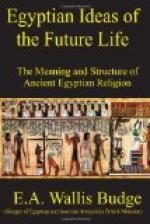With the subjects of resurrection and immortality must be mentioned the frequent references in the religious texts of all periods to the meat and drink on which lived the beings who were believed to exist in the world beyond the grave. In prehistoric days if was natural enough for the dead man’s friends to place food in his grave, because they thought that he would require it on his journey to the next world; this custom also presupposed that the deceased would have a body like unto that which he had left behind him in this world, and that it would need food and drink. In the Vth dynasty the Egyptians believed that the blessed dead lived upon celestial food, and that they suffered neither hunger nor thirst; they ate what the gods ate, they drank what they drank, they were what they were, and became in such matters as these the counterparts of the gods. In another passage we read that they are apparelled in white linen, that they wear white sandals, and that they go to the great lake which is in the midst of the Field of Peace whereon the great gods sit, and that the gods give them to eat of the food (or tree) of life of which they themselves eat that they also may live. It is certain, however, that other views than these were held concerning the food of the dead, for already in the Vth dynasty the existence of a region called Sekhet-Aaru, or Sekhet-Aanru had been formulated, and to this place the soul, or at least some part, of the pious Egyptian hoped to make its way. Where Sekhet-Aaru was situated we have no means of saying, and the texts afford us no clue as to its whereabouts; some scholars think that it lay away to the east of Egypt, but it is far more likely to represent some district of the Delta either in its northern or north-eastern portion. Fortunately we have a picture of it in the Papyrus of Nebseni, [Footnote: Brit. Mus., No. 9900; this document belongs to the XVIIIth dynasty.] the oldest probably on papyrus, and from this we may see that Sekhet-Aaru, i.e., the “Field of Reeds,” typified some very fertile region where farming operations could be carried on with ease and success. Canals and watercourses abound, and in one section, we are told, the spirits of the blessed dwelt; the picture probably represents a traditional “Paradise” or “Elysian Fields,” and the general characteristics of this happy land are those of a large, well-kept, and well-stocked homestead, situated at no great distance from the Nile or one of its main branches. In the Papyrus of Nebseni the divisions of the Sekhet-Auru contain the following:—
[Illustration: The Elysian Fields of the Egyptians according to the Papyrus of Nebseni (XVIIIth dynasty).]
1. Nebseni, the scribe and artist
of the Temple of Ptah, with his arms
hanging by his sides, entering the Elysian
Fields.
2. Nebseni making an offering of
incense to the “great company of the
gods.”
3. Nebseni seated in a boat paddling;
above the boat are three symbols
for “city.”




